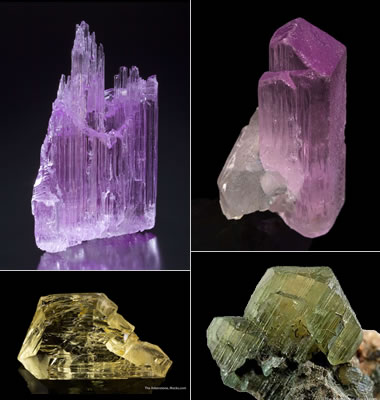
Color Varieties of Gem-Quality Spodumene: Gem-quality spodumene is named according to its color. Pink to purple specimens are known as kunzite, green specimens are known as hiddenite, and yellow specimens are known as triphane. Clockwise from top left: Purple kunzite from Afghanistan; pink kunzite from Afghanistan; yellowish green hiddenite from the Adams Hiddenite and Emerald Mine in North Carolina; yellow triphane from Afghanistan. Specimens and photos by Arkenstone / www.iRocks.com.
What Are Pyroxenes?
Pyroxene is the name of a group of dark-colored rock-forming minerals found in igneous and metamorphic rocks throughout the world. They form under conditions of high temperature and/or high pressure.
Augite, diopside, jadeite and spodumene are four of the best-known members of the pyroxene group; however, the pyroxene group has many other members.
Pyroxene minerals are defined by their chemical composition and crystal structure. Their generalized chemical composition is described by the formula and comments below.
XYZ2O6 Where X can be one or more of the following: Ca, Na, Fe++, Mg, Zn, Mn, or Li Where X can be one or more of the following: Ca, Na, Fe++, Mg, Zn, Mn, or Li
 Where Y can be one or more of the following: Mg, Fe+++, Fe++, Cr, Al, Co, Mn, Sc, Ti, or Vn Where Y can be one or more of the following: Mg, Fe+++, Fe++, Cr, Al, Co, Mn, Sc, Ti, or Vn
 Where Z can be Si, Al, or a combination of both Where Z can be Si, Al, or a combination of both
 A wide range of cation substitutions can occur in the X and Y positions. A wide range of cation substitutions can occur in the X and Y positions.
|
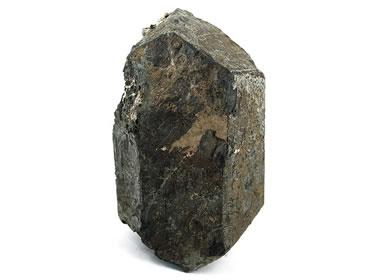
Augite: A specimen of the "jeffersonite" variety of augite. Approximately 11 x 6.3 x 4.3 centimeters in size. From the Franklin Mining District of Sussex County, New Jersey. Specimen and photo by Arkenstone / www.iRocks.com.
Uses of Pyroxene Minerals
Examples of individual pyroxene minerals that hold a place in industry and commerce are described below:
Spodumene
Spodumene often occurs in colorful gem-quality crystals. These beautiful blade-shaped crystals are highly prized by mineral collectors. When cut as gems, they have varietal names according to their color: kunzite (pink), hiddenite (green), and triphane (yellow).
Spodumene was once the most important ore of lithium metal - until the late 1900s, when subsurface brines with high concentrations of lithium were developed in Argentina, Chile, China and other locations. These brines can be pumped to the surface, allowed to evaporate, and lithium is easily processed from the evaporite material. Today, very little lithium is produced from spodumene.
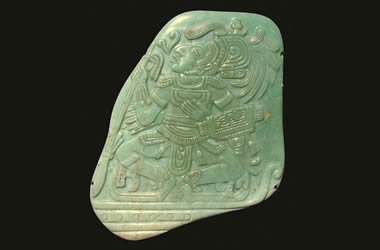
Mayan jadeite: Hand-made Mayan jadeite pectoral from the Mayan Classic period. This photo was taken by John Hill and is distributed under a GNU Free Documentation License.
Jadeite
Jadeite (a pyroxene) and nephrite (a member of the amphibole mineral group) are the only two minerals that can legally be called "jade" in commerce. Both of these minerals are used to produce cabochons, beads, bangles, small sculptures, and a wide variety of utility items. Jadeite is the most important gemstone in China, where it has been held in highest esteem for thousands of years. In Asia, high-quality jadeite can sell for prices that rival diamonds on a per-carat basis.
Although jadeite is not a mineral of exceptional hardness, it is a mineral of exceptional tenacity - which means that it is a durable material that resists breaking. Ancient people discovered this property and used jadeite to make weapons, impact tools, and cutting tools in parts of the world where the mineral was easily found as stream pebbles, cobbles, and talus.
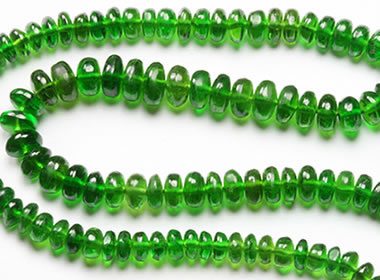
Chrome Diopside Beads: Rondelle-shaped beads cut from bright green chrome diopside mined in Russia. The beads range in size between 3 and 5 millimeters in diameter.
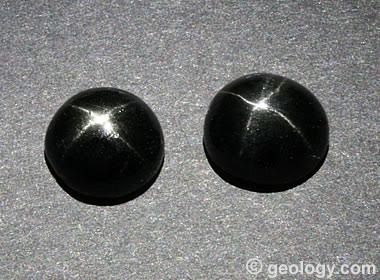
Star Diopside: A black star diopside cabochons exhibiting four-ray stars. They are slightly magnetic, indicating that the silk is probably magnetite crystals. These cabochons are approximately 8 millimeters across and we paid less than $30 for the pair.
Diopside
Diopside often occurs as a bright green, translucent to transparent gem that is cut into faceted stones, cabochons, and beads. Its green color is often bright enough that it is used as a substitute for emerald. A rare variety of diopside known as "star diopside" contains fine prismatic crystals of magnetite. When polished en cabochon, they display a silver four-ray star. The property of displaying a star is known as "asterism".
Diopside has potential uses in ceramics, glass-making, biomaterials, nuclear waste immobilization, and fuel cell technology. Unfortunately, natural diopside is rarely found in deposits that simultaneously have a size, purity, and location that allows economic mining. This makes synthetic diopside cost-competitive with diopside produced by mining.
Hypersthene and Enstatite
Rare specimens of hypersthene and enstatite sometimes display a colorful sheen known as "schiller". Rare specimens of enstatite will display asterism in the form of four-ray or six-ray stars. These specimens of gem-quality enstatite and hypersthene are so rare that they are "collector's stones" instead of gems frequently seen in jewlery.
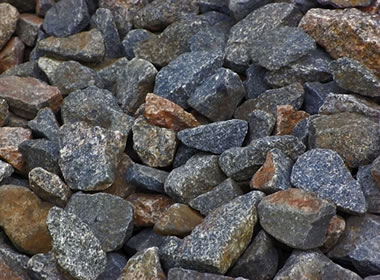
Crushed Trap Rock: "Trap rock" is a name used in the construction industry for any dark-colored igneous rock that is used to make crushed stone. These are usually diabase, gabbro, basalt, or peridotite that contain pyroxene minerals as an important part of their composition. Image copyright iStockphoto / Brilt.
Construction Materials
Pyroxene minerals are primary or secondary constituents of many rocks used to make crushed stone, dimension stone, and architectural stone. Pyroxene is in the trap rock of the construction industry and in the "black granites" that are popular for making decorative tile and facing stone.
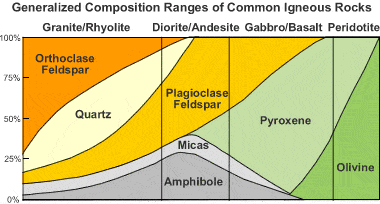
Generalized Composition Ranges of Common Igneous Rocks: This chart shows that pyroxenes are found in several types of igneous rocks.
Geologic Occurrence of Pyroxenes
In Earth's crust, pyroxenes are found in a wide range of igneous and metamorphic rocks. They are most abundant in the dark-colored igneous rocks, such as basalt and gabbro, that comprise most of the oceanic crust. Pyroxenes and plagioclase feldspar are the most abundand minerals in these rocks.
Pyroxenes are also important minerals in many peridotites. Rocks of the upper mantle are composed mainly of olivine and pyroxenes.
In the continental crust, pyroxenes are often accessory minerals in granite, rhyolite, diorite, and andesite. See the accompanying chart for a graphical representation of pyroxene presence in various igneous rocks.
Pyroxenes are not abundant in sedimentary rocks because pyroxenes rarely form at low temperatures and are very susceptible to chemical and physical weathering.
Physical Properties of Pyroxenes |
|
| Chemical Classification | Silicate |
| Color | Usually dark green to dark brown or black. Some, such as jadeite and spodumene, occur in a range of colors. |
| Streak | White |
| Luster | Vitreous to dull |
| Diaphaneity | Semi-translucent to opaque |
| Cleavage | Most pyroxene minerals exhibit two directions of cleavage that intersect at approximately 87o and 93o. Cleavage fragments often have a nearly square cross-section. |
| Mohs Hardness | 5 to 7 |
| Specific Gravity | 3 to 4 |
| Diagnostic Properties | Stubby prismatic crystals. Angle of cleavage plane intersection. |
| Chemical Composition | A generalized composition of XYZ2O6, as described in the accompanying sections. |
| Crystal System | Monoclinic or orthorhombic |
| Uses | Most pyroxenes have no regular use as industrial minerals. Pyroxene minerals are minor to secondary components of some rocks that are used as crushed stone and dimension stone. A few pyroxene minerals are used as gem materials, but only in rare instances when they have attractive color and clarity. Jadeite, diopside, and spodumene are the most important pyroxene gem materials. Spodumene was once an important source of lithium. |
Extraterrestrial Occurrence of Pyroxenes
Pyroxene minerals are known beyond Earth. They are abundant in many stone meteorites and present in some stony-iron meteorites. They have also been identified in the rocks and regolith of the Moon and Mars.
When compared to terrestrial rocks, rocks of the Moon and Mars have simple mineral compositions. This is because they have not been significantly altered by chemical weathering. Their composition is dominated by plagioclase feldspar and pyroxene minerals.
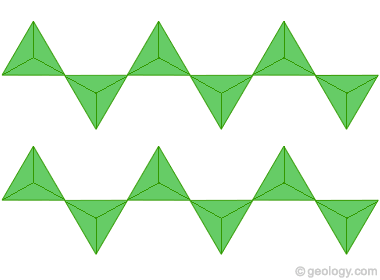
Single Chain Silicates: As silicate minerals, pyroxenes have the silica tetrahedron as their basic structural unit. Each silica tetrahedron consists of four oxygen ions that surround a single, and much smaller, silicon ion in the center of the tetrahedron. Pyroxene minerals are single-chain silicates. That means their silica tetrahedra are arranged in long single chains. Adjacent tetrahedra in the chain share a single oxygen atom at their connection points. The illustration above is a view looking down on two chains comprised of silica tetrahedra.

Metal Ions Between the Chains: This diagram is a view looking down the long axis of a pyroxene mineral. Each pair of green triangles is an end-view of a single chain of silica tetrahedra. You may remember that XYZ2O6 is the generalized chemical composition of a pyroxene mineral. The X and Y ions occupy positions between adjacent chains of tetrahedra, as shown in the diagram above.
Monoclinic and Orthorhombic Pyroxene
Pyroxene minerals crystallize in both the monoclinic and orthorhombic crystal systems. Monoclinic pyroxenes are known as "clinopyroxenes" and orthorhombic pyroxenes are known as "orthopyroxenes".
Pyroxenes can also be classified on the basis of their chemical composition. The classes include: magnesium-iron pyroxenes, calcium pyroxenes, calcium-sodium pyroxenes, sodium pyroxenes, and lithium pyroxenes.
Two lists of pyroxene minerals and their chemical compositions are presented below. One list contains clinopyroxenes, the other contains orthopyroxenes.
Monoclinic Pyroxenes (Clinopyroxenes) | |
| Aegirine | NaFe+++Si2O6 |
| Augite | (Ca,Na)(Mg,Fe,Al,Ti)(Si,Al)2O6 |
| Burnettite | CaVAlSiO6 |
| Clinoenstatite | MgSiO3 |
| Clinoferrosilite | Fe++SiO3 |
| Davisite | CaScAlSiO6 |
| Diopside | CaMgSi2O6 |
| Esseneite | CaFe+++[AlSiO6] |
| Grossmanite | CaTi+++ AlSiO6 |
| Hedenbergite | CaFe++Si2O6 |
| Jadeite | Na(Al,Fe+++)Si2O6 |
| Jervisite | (Na,Ca,Fe++)(Sc,Mg,Fe++)Si2O6 |
| Johannsenite | CaMn++Si2O6 |
| Kanoite | Mn++(Mg,Mn++)Si2O6 |
| Kosmochlor | NaCrSi2O6 |
| Kushiroite | CaAl[AlSiO6] |
| Namansilite | NaMn+++Si2O6 |
| Natalyite | NaV+++Si2O6 |
| Omphacite | (Ca,Na)(Mg,Fe++,Al)Si2O6 |
| Petedunnite | Ca(Zn,Mn++,Mg,Fe++)Si2O6 |
| Pigeonite | (Ca,Mg,Fe)(Mg,Fe)Si2O6 |
| Spodumene | LiAl(SiO3)2 |
Orthorhombic Pyroxenes (Orthopyroxenes) | |
| Hypersthene | (Mg,Fe)SiO3 |
| Donpeacorite | (MgMn)MgSi2O6 |
| Enstatite | Mg2Si2O6 |
| Ferrosilite | Fe2Si2O6 |
| Nchwaningite | Mn2+2SiO3(OH)2•(H2O) |
| Protoenstatite | Mg2Si2O6 |
| More Minerals |
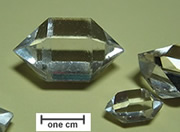 |
Herkimer Diamonds |
 |
The Acid Test |
 |
Tumbled Stones |
 |
Zircon |
 |
Fool*s Gold |
 |
Kyanite |
 |
Rock Tumblers |
 |
Rhodochrosite |

Find Other Topics on Geology.com:

|

| ||

|

| ||

|

| ||

|

|
